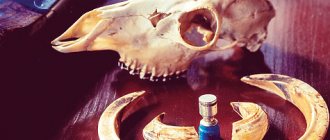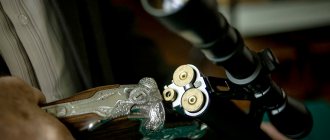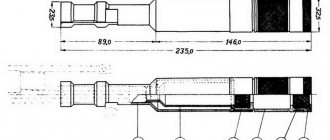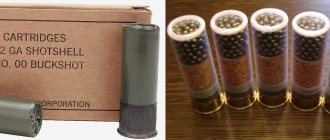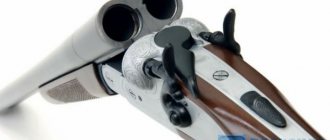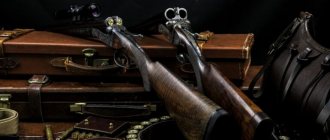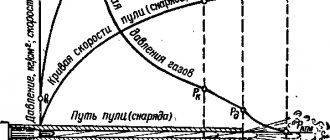03.06.2021
Smoothbore weapons are the first type of weapons available to a novice hunter. The first trophy is obtained from a smoothbore gun, and with a smoothbore gun the hunter receives the first emotions and satisfaction from the results of the hunt.
Smoothbore weapons are a flexible type of weapon that offers the hunter a large number of types of charges for hunting an animal of any size and complexity of prey. With a smoothbore gun you can go after waterfowl, and large animals such as wild boar and even elk.
To load a smoothbore shotgun, choose one of three types of equipment:
- Shot cartridges are equipped with identical small balls made of lead with a diameter of 1.5 to 5 millimeters. The choice of shot number is determined by the size of the prey and the season: in winter, the feathers or fur of birds and animals become denser and require greater destructive power from the projectile. They hunt hares, hog and waterfowl, and small ungulates with shot.
- Buckshot is the same shot with a larger charge of up to 8.5 millimeters, placed 3 pieces into the cells of the cartridge. It is selected for shooting at large animals - wolves, wild boars, deer and elk. Buckshot charges are not approved for collective hunting and for baiting animals with dogs. This can be dangerous.
- Bullets are monolithic striking elements, suitable for hunting different types of game. The difference between hunting with bullets: one shot, one hit.
Each of the listed types of charges has its own niche, advantages and disadvantages. However, no type of cartridge causes as much controversy as the appropriateness of choosing bullets for smooth-bore weapons. A large circle of experienced hunters claim that a smoothbore gun with the right bullets can give even a rifled gun a head start in shot accuracy and lethality. If there are those who do not accept any charges for a gun, except for shot and buckshot.
We will try to find out the truth and consider all aspects of hunting with bullets and purchasing cartridges for smooth-bore weapons.
Types of bullets for smooth-bore weapons
Over the history of firearms, many types of cartridges for smooth-bore hunting weapons have been developed. Let's start with the basics.
Bullets are combined into two large groups:
Caliber - the diameter of the bullet corresponds to the internal diameter of the barrel and when fired, the projectile is in close contact with the barrel.
Caliber bullets are characterized by high destructive power when shooting at close ranges, due to their larger size and high weight. These projectiles are insensitive to temperature changes and do not change their properties and ballistic performance in cold weather.
Sub-caliber - each bullet is placed in a separate container made of plastic or polyethylene. The size of the bullet itself is significantly smaller than the caliber of the gun.
Since the weight of a sabot bullet is less and the amount of gunpowder is standard, it can hit a target at greater distances than a caliber bullet. The polyethylene container protects the barrel from lead; as a result, the gun is cleaned less frequently, and it will take less time and require a minimum of reagents. But at the same time, the properties of the container can change as temperatures drop.
Bullet configurations are so diverse that a separate reference book will be required to describe them and fully characterize them, so we will list the popular ones.
The Brenneke is a hunting classic. This is a massive, heavy projectile that retains energy throughout its entire trajectory and shows high lethality at distances of up to 70 meters.
Gualandi - bullets produced in the form of caliber and sub-caliber charges. High penetration rates are appropriate in hunting large animals - wild boar, elk, bear. At a distance of up to 80 meters it easily penetrates the bones of the skull.
Mayera is a bullet designed for large animals, therefore it has a mass of 34 grams and high destructive power.
Polev bullets are a category of sub-caliber charges suitable for hunting small game. They are lightweight and have high initial speed.
The baybak is a light torpedo-shaped bullet for hunting medium-sized animals - wolves, foxes, jackals.
Grizzly is a heavy projectile with high starting energy for catching the largest trophies.
A round bullet is a lead ball that has not changed in the history of firearms since the invention of the cannon. Suitable for all types of shotguns and helps achieve results unattainable with other loads.
And this is not the entire list of common types of bullets. And each hunter chooses the best bullets for smooth-bore weapons based on experience and preferences.
A little theory
To begin with, bullets can be divided into two types:
- Caliber - in this case, the body of the bullet itself is in direct contact with the walls of the barrel.
- Sub-caliber, they are also container - the bullet is enclosed in a so-called container, usually made of polyethylene, and the diameter itself is smaller than the diameter of the barrel. Accordingly, when it passes through the barrel, it does not come into contact with its walls - the container does this for it.
What are the advantages of both types of bullets? Let's start with the sub-caliber ones:
- Longer shot range and flatter trajectory. This is achieved due to the lighter weight of the bullet itself, with the same amount of gunpowder used, as well as better (usually) aerodynamics.
- Less lead in the barrel is due to the fact that the container is in contact with its walls, and not the bullet itself.
What then are caliber ones? They have their advantages:
- Much greater stopping effect when shooting at close range. This is achieved due to the fact that such a bullet, being heavier and wider than a sub-caliber one, transfers significantly more energy to the animal directly upon impact.
- Insensitivity to frost - in the cold, the polyethylene container of sub-caliber bullets tends to harden, and, due to this, they begin to behave differently than at normal temperatures. Caliber bullets do not have such a drawback - their ballistics remains unchanged regardless of the value of the thermometer.
What conclusion can we draw from this? That's right - we need to look at what kind of animal and at what distance we are going to hit. Someone dangerous and large, who, moreover, will rush at us or let us come close to him - like a seasoned cleaver or a bear? Then you should choose a heavy caliber bullet - in order to be sure to stop an evil and wound-resistant beast, and not wait until it dies from blood loss, while collecting in a heap its own intestines, released during the attack. Are we planning to shoot at a longer distance, or are we confident that we can accurately hit the prey in its lethal zone? Then our choice is a sub-caliber bullet.
Calibers of cartridges for smoothbore weapons
The caliber of the weapon plays a huge role in the choice of cartridges and determines the ballistic parameters of the shot. Therefore, now we will try to consider the most common calibers and evaluate the advantages of each.
Caliber 12
This caliber is more widely represented in the assortment of gun stores than others; it is easy to find 12-gauge cartridges even in the outback. Cartridges of this caliber are loaded into various shotguns produced by the largest companies in the world, and the cartridges themselves are mass produced and at affordable prices. A striking example is the American Magnum cartridges, which have more than 25 types of cartridges for smoothbore shotguns under 12 gauge.
The second reason for its popularity was versatility. 12 gauge cartridges are available with all three types of charge and are taken for hunting both poultry and animals up to the size of elk.
Another advantage of 12 gauge bullets is their ease of use. Shots with a large shot allow novice hunters to hide aiming errors and achieve results even in the first stages of preparation.
If we consider the issue from the point of view of choosing a weapon, then a huge number of weapon models from domestic manufacturers, as well as popular factories in America, Britain, Germany and Italy, have been produced and continue to be produced for 12 gauge. Among them, it is easy to choose a suitable model both in design and price.
The disadvantages of 12 gauge are:
- Large recoil when fired and noticeable tossing of the barrel upward.
- Moderate shooting sharpness.
- A small area of shot debris when hitting a target.
Thus, 12 gauge is the best choice of bullet for a smoothbore weapon if you want, with a single gun, to effectively hunt a variety of game in various conditions.
Caliber 16
This was the most popular caliber until the 90s. Bullets for 16-gauge smoothbore weapons, according to many hunters, are superior to 12-gauge in many respects:
- The gun weighs less, which is convenient for walking hunting and long stays in ambush.
- Soft, moderate recoil with a weak shotgun throw allows you to spend less time preparing a second shot.
- High shot sharpness, decent firing range and accuracy of hitting the target.
The main disadvantages of this caliber were the small range of guns and their high prices. However, professional hunters will prefer this caliber.
Caliber 20
This caliber is called a commercial caliber because it is preferred by hunters for whom hunting is a business and a source of income, and not a weekend hobby. 20-gauge shotguns hit cleanly and powerfully, leaving no wounds. 20 gauge is the choice for using a bullet for a smoothbore caliber. Only it guarantees an accurate hit and high lethality at distances of up to 100 - 120 meters.
If we talk about the cost of cartridges, the situation is twofold. When assembling cartridges yourself, 20 gauge provides minimal powder consumption. And if you buy ready-made cartridges, their price will exceed previous calibers in some cases by 2 times.
How to choose cartridges, what to look for?
The variety of bullets for smooth-bore weapons naturally leads to the fact that many hunters experience certain difficulties in choosing a charge for a specific gun and certain hunting conditions.
To select hunting bullets for smoothbore weapons, you should evaluate your future hunt in advance according to the following plan:
- Choose the type of prey, that is, know in advance who is being hunted. It is the weight of the bullet that determines its destructive ability, and therefore is selected specifically for the prey. For hares and marmots you can use bullets weighing up to 10 grams, and for large animals there are even charges weighing 43 grams;
- Determine the type of hunt. Since the type of bullet determines such parameters of the shot as range, lethality and accuracy of fire, a pre-planned hunting plan will be appropriate. For hunting from the approach, from a tower and from a concealed spot, you will need different bullets;
- Study the design features of the gun you are going fishing with and select bullets for the barrel configuration.
Let us dwell on the last point in more detail, since when deciding which cartridges to choose for a smooth-bore weapon, in case of an error, you can simply destroy the gun with a few shots. 90% of smooth-bore weapons have muzzle constrictions - chokes. There are modifications of double-barreled shotguns with different chokes for each channel. In such cases, a separate bullet is selected for each double-barreled shotgun barrel.
The best ammo for your shotgun should take into account the barrel configuration. The principle of selecting bullets for chokes is as follows:
- If the barrel bore is a smooth cylinder without narrowing, use any type of bullet for shooting;
- If the constriction is up to 0.25 mm, the design is called a cylinder with pressure and allows you to load various types of caliber bullets and round sabots;
- A narrowing of 0.5 mm is called halfway and requires the purchase of special sub-caliber bullets;
- A 0.75mm choke is called a medium choke and also requires a sub-caliber bullet load;
- Full-size choke - a 1 mm constriction requires the selection of only special sub-caliber round bullets;
- Narrowing by 1.12 mm - reinforced choke. For hunting rifles with a similar barrel configuration, it is prohibited to use bullets, only buckshot and shot.
Some models of shotguns are equipped with replaceable chokes, which are threaded onto the muzzle of the barrel. It is prohibited to shoot from such models without one of the attachments. Since even a single shot will ruin or break the thread, as a result, the use of replaceable chokes will become impossible, which means the gun will lose its functionality.
General typology
Before diving into the world of bullets, the shortest important classification of pneumatics for this matter is: pneumatics with a smooth barrel and with a rifled barrel. Rifles, by definition, come with a rifled barrel; pistols come with both rifled and smooth barrels. Typical representatives of air pistols firing lead bullets: MP-651, A-3000 "Skif", IZH-53M, Umarex Beretta 92S and Walther CP88, as well as revolvers like Gletcher SW R25. That’s all for now, we already have a whole article here about types of barrels and examples of weapons.
Pneumatic bullets are made of lead or steel. Lead bullets are used for rifled barrels, steel bullets for smooth ones. Steel ones are made in the form of a ball (BB), lead ones are usually in the form of a familiar shooting range bullet with a head and a “skirt”.
In flight, rifle bullets are stable, the head is heavier than the skirt, and the rifling sets the spin. They have low friction in the barrel (touching occurs only with the edge of the head and skirt). For shooting at near and supersonic speeds, it is recommended to use bullets with an ogival shape, where the laws of aerodynamics already remove a regular bullet from a state of stability. To maintain their shape, but for use in more powerful samples, bullets are increased in weight by increasing the caliber, while maintaining stability and high muzzle energy.
The most popular pneumatic caliber is 4.5 mm (.177). Hunting samples use the mentioned increase in caliber - 5.5 mm (.22) and 6.35 mm (.25). In factory production there are bullets up to a caliber of 12.7 mm (.50), in practice there are even more homemade ones. Ideally, bullets are selected individually in batches for a specific barrel. For fans of precision fitting, some manufacturers even assign a skirt diameter to their bullets (for example, 4.50 mm, 4.52 mm).
The mass for bullets is indicated in grams. The USA and some Western countries like to use grains to measure it. 1 gram – 0.062 grains. The vast majority of bullets for pneumatics up to 7.5 J fall within the range of up to 0.55 g. Here it is worth understanding that weak pneumatics are not capable of accelerating a heavy bullet to a speed that ensures its stability and effective energy transfer. A light bullet, on the contrary, will quickly lose energy, not providing stability at a distance. So selecting the bullet weight for an air gun is also an individual matter.
